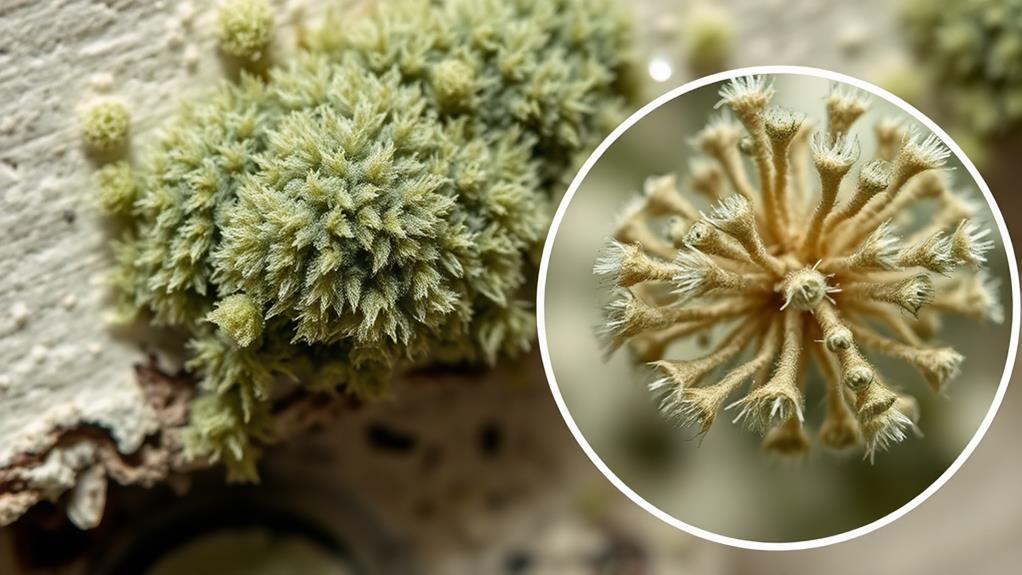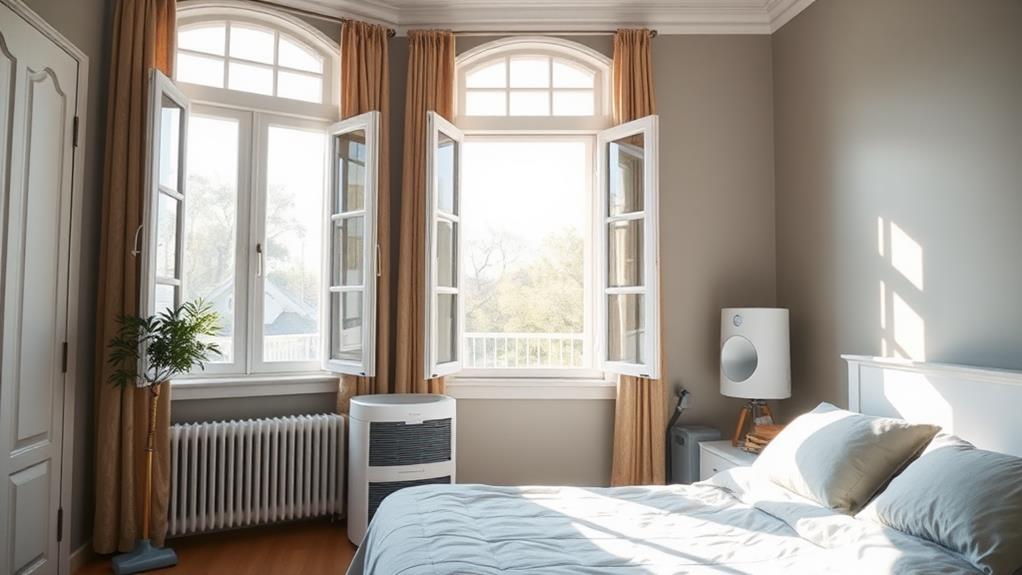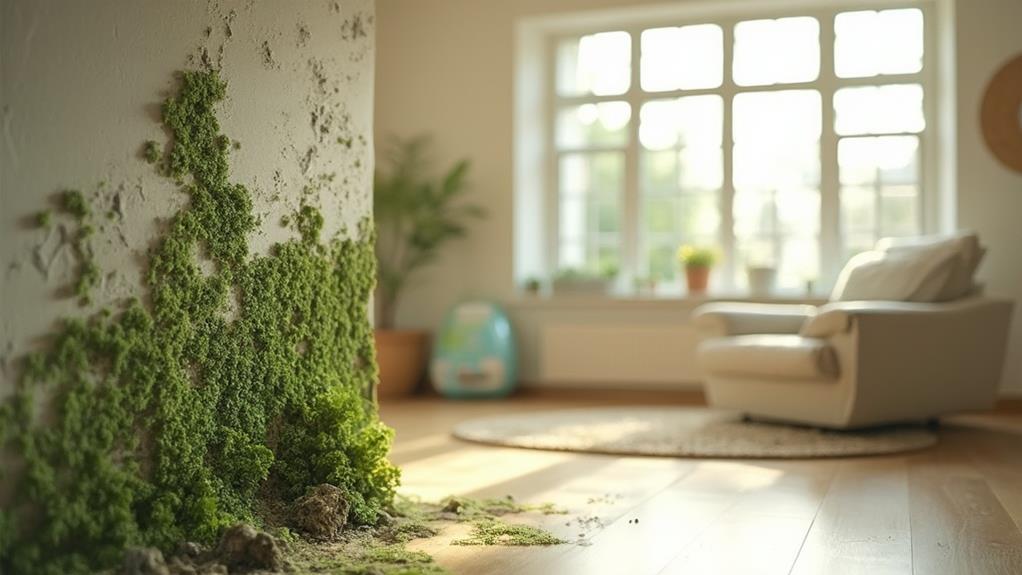Mold growth significantly impacts indoor air quality, releasing spores and potentially harmful mycotoxins. These contaminants can trigger allergic reactions, respiratory issues, and other health problems in occupants. Common sources include bathrooms, kitchens, and areas with water damage or high humidity. To improve air quality, maintain proper ventilation, control moisture levels, and promptly address water intrusion. Regular cleaning, using HEPA filters, and employing dehumidifiers can help prevent mold growth. For existing infestations, thorough cleaning or professional remediation may be necessary. Implementing long-term strategies for moisture management and air quality control is crucial for maintaining a healthy indoor environment. Further exploration reveals additional effective measures for combating mold-related air quality issues.
Understanding Mold and Its Growth

Mold is a type of fungus that thrives in damp, warm environments and reproduces by releasing spores into the air. These microscopic spores can easily become airborne and spread throughout indoor spaces, potentially causing various health issues when inhaled. Mold requires three key elements to grow: moisture, a food source, and a suitable temperature range.
Moisture is the primary catalyst for mold growth, often resulting from water leaks, high humidity, or poor ventilation. Common food sources for mold include organic materials such as wood, paper, fabric, and even dust. Mold typically thrives in temperatures between 60°F and 80°F, which unfortunately coincides with the comfort range for most indoor environments.
Mold can grow rapidly under favorable conditions, sometimes becoming visible within 24 to 48 hours of moisture exposure. It often appears as discolored patches on surfaces, ranging from white and gray to green, brown, or black. Some molds produce a musty odor, which can be an early indicator of their presence. Understanding these growth factors is crucial for preventing mold infestations and maintaining healthy indoor air quality.
Health Risks Associated With Mold
Exposure to mold can lead to a variety of health issues, ranging from mild allergic reactions to more severe respiratory problems. Common symptoms include nasal congestion, throat irritation, coughing, wheezing, and eye irritation. For individuals with pre-existing conditions such as asthma or allergies, mold exposure can exacerbate their symptoms and trigger asthma attacks.
Prolonged exposure to mold may result in more serious health complications, particularly for vulnerable populations like children, the elderly, and those with compromised immune systems. These individuals are at higher risk of developing fungal infections, chronic lung illnesses, and other respiratory diseases. Some molds produce mycotoxins, which can cause neurological problems and affect the immune system.
In rare cases, exposure to certain types of mold, such as Stachybotrys chartarum (black mold), has been linked to severe health issues like pulmonary hemorrhage. While the connection between mold and these extreme health effects is still debated, it underscores the importance of addressing mold problems promptly. To protect your health, it's crucial to identify and remediate mold growth in indoor environments, maintaining proper ventilation and moisture control to prevent future infestations.
Common Sources of Indoor Mold

Numerous factors contribute to the growth of indoor mold, with moisture being the primary catalyst. Common sources of indoor mold include areas prone to water accumulation or high humidity.
Bathrooms, kitchens, and basements are particularly susceptible due to their frequent exposure to water and moisture. Leaky pipes, roof damage, and poor ventilation can create ideal conditions for mold growth in these spaces.
Window sills and frames often harbor mold due to condensation buildup, especially in areas with significant temperature differences between indoor and outdoor environments. Air conditioning units and HVAC systems can become breeding grounds for mold if not properly maintained, as they collect moisture and circulate spores throughout the building.
Carpets, upholstered furniture, and drywall are also common sources, particularly after water damage or flooding incidents. Even seemingly innocuous items like houseplants and their soil can contribute to mold growth if overwatered or lacking proper drainage. Identifying and addressing these common sources is crucial for maintaining good indoor air quality and preventing the health risks associated with mold exposure.
Detecting Mold in Your Home
Effectively detecting mold in your home often requires a combination of visual inspection, olfactory awareness, and sometimes professional assistance. Begin by thoroughly examining areas prone to moisture, such as bathrooms, kitchens, basements, and around windows. Look for visible signs of mold growth, which can appear as dark spots, patches, or fuzzy growths on surfaces. Pay attention to musty or earthy odors, as these can indicate hidden mold problems.
Check for water stains, discoloration, or peeling paint on walls and ceilings, as these may suggest underlying moisture issues conducive to mold growth. Inspect the back of drywall, wallpaper, or paneling for signs of mold. Use a flashlight to examine dark corners and crevices. If you suspect mold but cannot visually confirm its presence, consider using a mold testing kit or hiring a professional mold inspector. These experts can conduct thorough assessments, including air quality tests and moisture measurements, to identify hidden mold problems.
Remember that some mold may be concealed within walls or under flooring, requiring more invasive inspection methods. Early detection is crucial for preventing extensive mold growth and mitigating potential health risks associated with prolonged exposure.
Preventing Mold Growth

Vigilance is key in preventing mold growth within your home. To effectively combat mold, focus on controlling moisture levels and reducing humidity. Maintain proper ventilation in high-moisture areas like bathrooms, kitchens, and laundry rooms by using exhaust fans or opening windows. Fix any leaks promptly, including those in pipes, roofs, and windows, to prevent water accumulation.
Keep indoor humidity levels below 60% by using dehumidifiers in damp areas. Ensure proper drainage around your home's foundation to prevent water from seeping into basements or crawl spaces. Regularly clean and dry areas prone to moisture, such as shower curtains, bathroom tiles, and windowsills. Use mold-resistant products when renovating or building, especially in moisture-prone areas.
Improve air circulation throughout your home by keeping interior doors open and using fans. Avoid storing items in damp areas, and periodically check hidden spaces like attics and crawl spaces for signs of moisture or mold. Finally, maintain your HVAC system by regularly changing filters and cleaning air ducts to prevent mold spores from circulating throughout your home.
Effective Mold Removal Techniques
Several effective techniques exist for removing mold from indoor spaces, each tailored to the severity of the infestation and the affected surface. For small areas (less than 10 square feet), homeowners can often handle the removal themselves using a mixture of water and detergent or a commercial mold cleaner. Scrubbing the affected area with a stiff brush, followed by thorough drying, can be effective for non-porous surfaces.
For larger infestations or porous materials, professional remediation is recommended. Professionals may use specialized equipment such as HEPA vacuums, air scrubbers, and negative air machines to contain and remove mold spores. They may also employ techniques like dry ice blasting or soda blasting for stubborn mold on hard surfaces.
In cases of severe mold growth, removal of affected building materials may be necessary. This can include cutting out and replacing drywall, wood, or insulation. After removal, treating the area with a fungicidal solution helps prevent regrowth. It's crucial to address the underlying moisture issue to prevent future mold growth. Post-remediation, professional air quality testing can confirm the successful elimination of mold spores from the indoor environment.
Improving Indoor Air Quality

Improving indoor air quality after mold remediation involves a multi-faceted approach. First, ensure proper ventilation by opening windows regularly and using exhaust fans in high-moisture areas like bathrooms and kitchens. Install and maintain HVAC systems with high-quality air filters to trap airborne particles and spores. Consider using portable air purifiers with HEPA filters in problem areas or rooms with poor circulation.
Maintain indoor humidity levels between 30-50% using dehumidifiers or air conditioners. Regularly clean and vacuum surfaces, including carpets and upholstery, using HEPA-filtered vacuums to prevent mold spores from becoming airborne. Address any water leaks or moisture issues promptly to prevent future mold growth.
Incorporate indoor plants known for their air-purifying properties, such as spider plants or peace lilies. However, be cautious not to overwater them, as this can contribute to excess moisture. Use mold-resistant products when renovating or repairing areas prone to moisture. Finally, consider professional air quality testing to ensure that remediation efforts have been successful and to identify any remaining issues that may need attention. By implementing these strategies, you can significantly improve indoor air quality and maintain a healthier living environment.
Long-Term Mold Management Strategies
Effective long-term mold management strategies are crucial for maintaining a healthy indoor environment. These strategies focus on preventing mold growth and addressing underlying issues that contribute to its proliferation. Regular inspections of high-risk areas, such as basements, bathrooms, and kitchens, should be conducted to detect early signs of mold growth or moisture problems.
Implementing proper ventilation systems and maintaining optimal humidity levels (between 30-50%) are essential components of long-term mold prevention. This can be achieved through the use of dehumidifiers, exhaust fans, and HVAC systems with adequate filtration. Additionally, addressing structural issues that allow water intrusion, such as leaky roofs or plumbing, is critical for preventing mold growth.
Developing a comprehensive moisture management plan is also vital. This includes prompt cleanup of spills, proper drainage around the building's exterior, and regular maintenance of gutters and downspouts. Educating occupants about mold prevention practices, such as drying wet items promptly and avoiding carpet in moisture-prone areas, further supports long-term mold management efforts. By implementing these strategies consistently, property owners and managers can significantly reduce the risk of mold-related indoor air quality issues.
Frequently Asked Questions
Can Mold Grow on Synthetic Materials Like Plastic or Polyester?
Yes, mold can grow on synthetic materials like plastic and polyester. While these materials don't provide nutrients, mold can thrive on organic matter, dust, or moisture accumulated on their surfaces, especially in humid environments.
How Quickly Can Mold Spread in Ideal Conditions?
Mold's momentum can be mightily menacing. In ideal conditions, mold spores spread swiftly, potentially proliferating across surfaces within 24-48 hours. Warm, damp environments accelerate growth, allowing colonies to expand exponentially and cover considerable areas rapidly.
Are Some Types of Mold More Resistant to Removal Than Others?
Yes, certain mold types are more resistant to removal than others. Species like Stachybotrys (black mold) and Aspergillus can be particularly challenging to eradicate due to their robust spore structures and ability to penetrate porous materials deeply.
Can Mold Spores Remain Dormant for Extended Periods of Time?
Yes, mold spores can remain dormant for extended periods, potentially years, under unfavorable conditions. They can survive in a state of suspended animation, awaiting suitable environmental factors such as moisture and nutrients to germinate and grow.
Does Mold Have Any Beneficial Uses in Indoor Environments?
While mold generally poses health risks in indoor environments, certain species have beneficial applications in controlled settings. These include food production (e.g., cheese-making), medical research, and potential bioremediation uses. However, uncontrolled mold growth indoors remains hazardous.
Conclusion
Mold's impact on indoor air quality is significant and multifaceted. Recent studies suggest that certain mold species may have antimicrobial properties, potentially benefiting air quality in controlled environments. However, the overall negative health effects of mold exposure outweigh any theoretical benefits. Effective mold management requires a comprehensive approach, including moisture control, proper ventilation, and prompt remediation. By implementing these strategies, individuals can substantially improve indoor air quality and safeguard occupant health.

